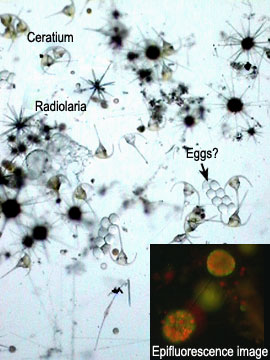

The summer Station 4 plankton net tow assemblage had two species of Ceratium dinoflagellate. The unuusal groups of colorless circular "blobs: are likely floating egg sacs. Also present were radiolaria: amoeboe with radial spines that can have symbiotic relationships with phytoplankton. To see whether chlorophyll was present, we viewed these radiolaria under fluorescent conditions. The red dots in the epifluorescence image (bottom right) clearly show chloroplasts. These symbionts are dinoflagellate zooxanthellae, like those found in coral reefs. Thus radiolaria gain some of their energy directly from sunlight. Learn more about epifluorescence techniques from the J.J. MacIssac Facility for Individual Particle Analysis.

